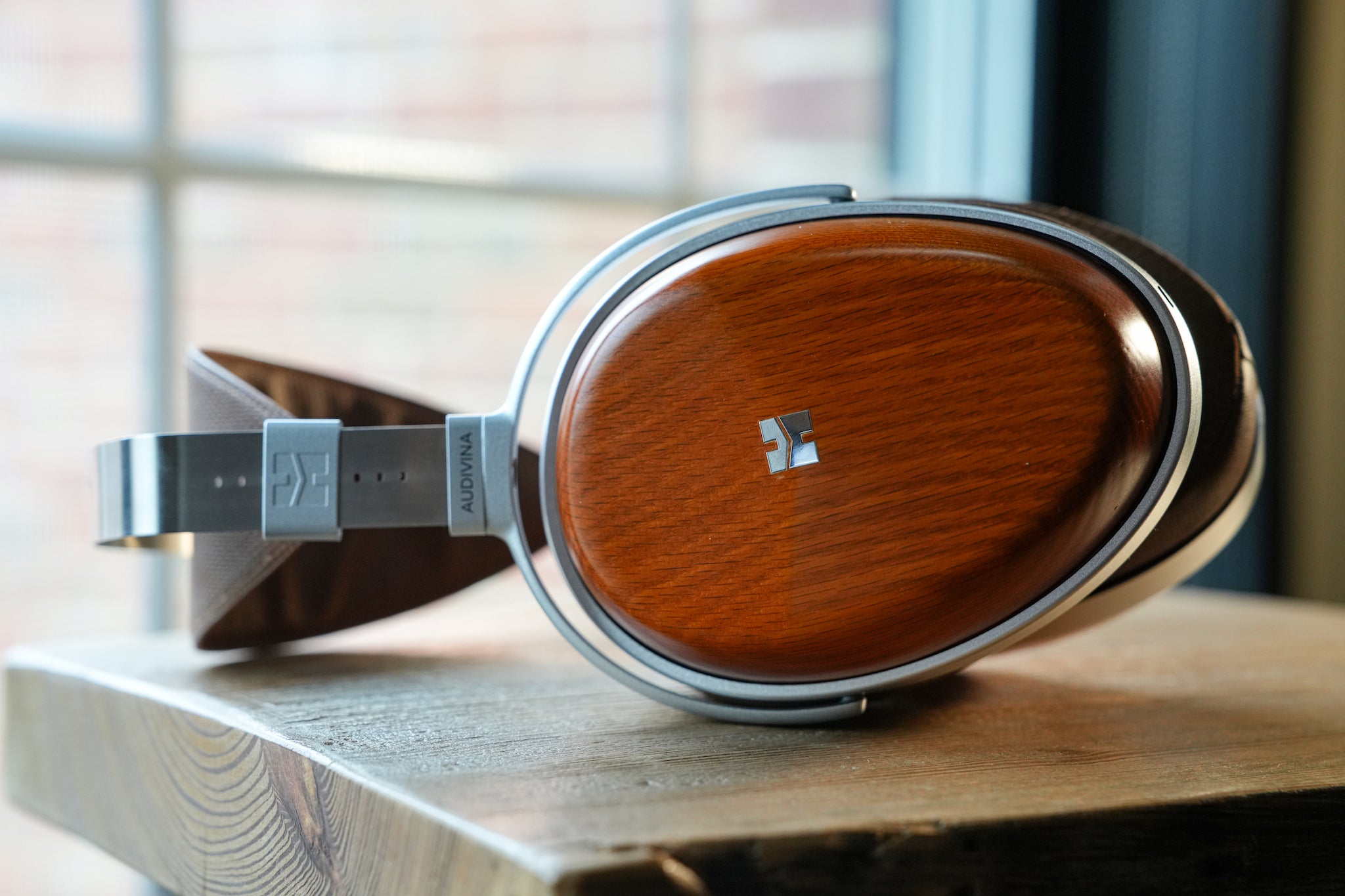One of the greatest challenges in the last generation of headphones has been creating a closed-back planar magnetic headphone that’s genuinely competitive with open-backs. Dan Clark has achieved quite a bit of success using their metamaterial tuning system in the Stealth, and HIFIMAN has also worked on solutions involving the shape and internal dampening of the earcups like in the HE-R10P. Audivina goes for a straightforward approach, not unlike the Focal Stellia, with a more traditional closed-back design and damping. Are its stealth magnets and back-to-basics approach enough to achieve closed-back planar magnetic excellence?
Build and Design
Audivina is one of HIFIMAN’s best looking headphones. It features their flagship style headphone band, wood cups, and brown hybrid leatherette pads. There’s a distinctly vintage style to the cognac colored leather and translucent finish on the wood cups that captures a strong sense of consistency in style.
In addition to the flagship style headband, Audivina comes with a flagship style package, including XLR, 6.3mm, and 3.5mm cables, and a box which is a step up from the more plain packaging of more recent HIFIMAN releases. The cables are an interesting combination of HIFIMAN styles, with the lengths and terminations you typically get with an HE1000 or Susvara, but the black rubber wrap that’s closer to Arya’s cable. While the aesthetic doesn’t totally match, I actually prefer the feel of the Audivina cables to HIFIMAN’s standard flagship cable.
In terms of the comfort and usability, Audivina is lightweight and very comfortable, and its headband adjustment works well. I also found it to be generally non-fatiguing during use – where closed-back headphones can have issues with pressure causing fatigue outside of the typical fatigue from different frequency ranges. At least part of that non-fatiguing feeling comes from the fact that this isn’t a headphone which provides particularly strong noise isolation. At low volumes you can’t hear much, but at moderate to high volumes there’s a significant amount of bleed, likely due to the somewhat gentle clamp force and well ventilated pads.
Sound
Audivina’s general tuning characteristics are quite good, but probably the biggest and most notable thing that hits you with Audivina is just how spacious and open it sounds for a closed-back headphone. If HIFIMAN has achieved anything with these headphones, it’s in the feeling of space and air around the listener that seems to defy the laws of physics for a closed-back headphone.
The bass is generally natural feeling with a slight midbass emphasis that can result in a touch of muddiness with some pairings, but is generally well-controlled. There’s some rolloff into the subbass, but generally good balance in the bass.
The midrange provides good detail and a generally neutral timbre. While the layers of music are clear and well separated, there’s also sometimes a lack of cohesion where Audivina makes some sacrifices in the blending of instruments to create a broader sense of space.
In the treble you get classic HIFIMAN with a top-end that exerts a bit of presence over the bass, making the overall tonal balance just barely treble forward. Audivina gives you just that right amount of sparkle, sizzle, and air without being fatiguing or harsh in the treble.
Where Audivina unquestionably shines is in the soundstage. This is among the widest, most three dimensional soundstages I’ve heard in a closed-back. The imaging favors separation over cohesion, giving you voices and instruments which are spread over a wide field for something like an out-of-body experience in the imaging.
Kings of Leon’s “Use Somebody” demonstrates Audivina’s spacious soundstage, with the headphones delivering a sense of a width worthy of an arena stage between the guitars. The drums hit with a nice impact, particularly coming from the bass drum, while the snare has plenty of snap. Even at the songs biggest moments, Audivina doesn’t give in to muddiness, keeping the mix clear and the space between instruments well defined.
Michael Giacchino’s The Batman Score leans towards more atmospheric work than past Batman movie soundtracks – like Danny Elfman’s take – and “Mayoral Ducting” again highlights Audivina’s imaging as it delivers a steady, throbbing bass right down the middle, and assortment of subtle music accents which move across different parts of the stage. Audivina captures the dark timbre of the song along with the brighter tones which sweep through for an almost uncomfortably eerie delivery of the piece.
Just when you think the opening horns on John Coltrane’s “Blue Train” are maybe a little smooth, Coltrane’s saxophone lead cuts through the mix with a nice helping of bite and energy to drive the song forward. Audivina’s imaging and tonal balance is perfectly suited to this style of jazz, with a natural overall feeling and a sense of separation that nicely manages the space between each instrument. The slightly midbass forward low end highlights the kick and bass, anchoring the song with the strong rhythm section.
Comparison 1: HIFIMAN Arya
The biggest question that we’ve gotten since Audivina was announced is “does it sound like a closed-back Arya?” And while it’s very hard to make an honest comparison between closed-back and open-back headphones, there’s plenty of comparisons between these two headphones worth talking about.
The sound signatures are fairly close, but the emphasis is shifted around a bit. Arya extends deeper with a more linear bass, while Audivina peaks in the midbass and doesn’t perform as strongly through the subbass. In the midrange, Arya gives a little more weight and body to the instruments and has slightly more emphasis on the vocals, but the overall sense of separation isn’t as strong as Audivina. Arya’s treble is a bit more crisp and clear, but Audivina has slightly stronger timbre at the top end with less tendency towards metallic overtones.
Arya ultimately presents a larger soundstage with stronger, more holographic imaging, but most of the differences between the two are fairly minor and a matter of a few degrees. Considering the technical limitations of a closed-back, Audivina comes as close as you could hope – and probably closer than you expected – in delivering Arya DNA in a closed back headphone.
Comparison 2: Meze Liric
HIFIMAN and Meze are well known for landing on different ends of the audiophile spectrum, with products in the same price range that appeal to different tastes. Liric and Audivina might be the closest comparison yet between the two headphones, with some similar characteristics, and some ways that each has a clear advantage.
While Meze is renowned for their artistic design, at first glance, Audivina is the one with the bigger wow factor, but Liric is a little better at blending in with a more simple black design. The comfort will be subjective with many preferring the extra space afforded by HIFIMAN’s teardrop style earcups, but the materials and padding used in the Liric have a more luxurious feel to them.
In terms of sound, Audivina hits a little bit closer to neutral, and really presents more like an open-back headphone. Liric has stronger bass extension, while Audivina has more midbass, and stays stronger through the mids, where Liric is more recessed. Liric’s treble is also smoother at the very top, where Audivina extends for a little more air.
But I found the most noticeable difference between the two to not be so much in the tuning, but in the way the imaging is presented. Audivina has a much larger soundstage but a generally more airy, diffuse presentation of the image. Liric imaging feels more grounded. The soundstage is smaller, with a similar three dimensional feeling, and more tactile imaging. Where Audivina gives you a huge space, and spreads the instruments out into the distance, Liric has a smaller more intimate space, coupled with more of a sense that you could reach out and touch the music.
The Bottom Line
From the wide soundstage to the airy highs, it captures a lot of the characteristics that HIFIMAN is best known for, and somehow squeezes them all into a closed back package. Audivina might not be the best closed-back headphone on the market, but it’s almost certainly the one that HIFIMAN fans have been waiting for.










